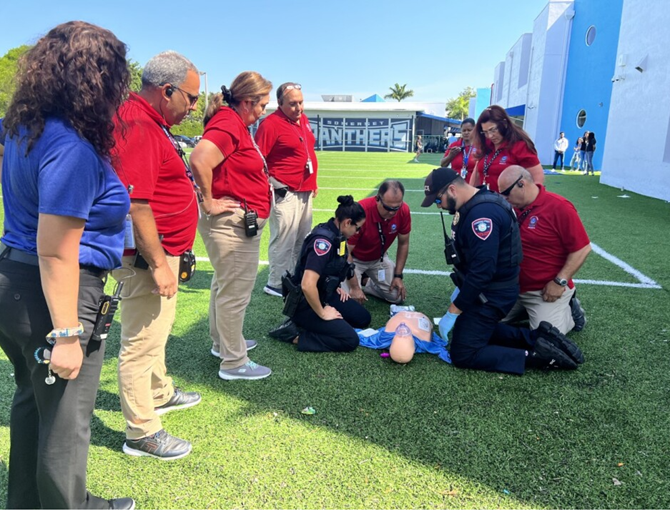Though rare, sudden cardiac arrest (SCA) in the young causes tragic events that impact the entire community. Roughly 7,000 people under the age of 18 will suffer a cardiac arrest annually in the U.S. Because of education and hands-on training to school faculty, countless lives have been saved nationally. In just two years, eight lives have been saved in South Florida schools.
“Lethal arrhythmias may be the first presentation of structural cardiac anomalies, cardiomyopathies and channelopathies,” says Melissa Olen, MSN, FNP-C, CCDS, at Nicklaus Children's Hospital. “Early detection, conventional cardiopulmonary resuscitation and use of an automated external defibrillator (AED) save lives and optimize the neurological outcomes.”
To help protect children affected by SCA, the Nicklaus Children's Heart Institute is an affiliate of Project ADAM and is sharing this lifesaving program throughout the South Florida community.
Preparing with Project ADAM
Project ADAM is a nonprofit organization that provides education and lifesaving programs to school systems. Schools seeking to join Project ADAM go through a four-step process.
- Step 1: Nicklaus Children's experts provide educational materials to school leaders. This material teaches administrators about SCA and the tools and techniques to help children survive SCA. Administrators also gain hands-on training with the tools, notably AEDs. Team members then work with administrators to create a plan to properly respond in the event a child experiences a cardiac emergency while in their care.
- Step 2: The school undergoes a scheduled drill under the oversight of the Nicklaus Children's Project ADAM coordinator. This drill aims to assess the response of all team members at the school, ensuring proper communication between the team, response efficiency, CPR performance and AED application. To become a “Heart Safe Recognized” school, the team must be able to demonstrate the lifesaving teamwork and deliver the first AED shock in less than three minutes.
- Step 3: Nicklaus Children's staff members provide a 10- to 15-minute debriefing period. While debriefing, staff members review the results of the scheduled drill and provide feedback that encourages participants and provides insight that leads to improved success in the future.
- Step 4: Administrators receive a banner highlighting their school as a Heart Safe Recognized School. This serves as notice to families and the community at large that the specific school is armed with skills necessary to recognize a child experiencing SCA and take appropriate, lifesaving action.
To promote ongoing best practices, the Project ADAM team recommends the emergency response team to perform a cardiac arrest drill annually. If performed annually, they will become just as routine as a fire drill.

Overcoming AED Hesitancy
According to research published in Resuscitation Plus, earlier use of AEDs leads to improved outcomes. For every minute that an AED is delayed, the chance of survival decreases by 10 percent. Although easy-to-use, Olen finds that without hands-on practice and familiarity, bystanders may be reluctant to use this sophisticated medical device.
“Using an AED is currently the only way to restore a regular rhythm, but too many times an available AED goes unused because of hesitancy and a lack of confidence,” Olen says. “This program gives hands-on practice to help school administrators become comfortable and confident enough to use an AED in the midst of an emergency situation.”
Since becoming an affiliate of Project ADAM in 2022, Nicklaus Children's has trained school faculty at 425 schools. As of April 2024, 100 percent of Miami-Dade County Public Schools are Heart Safe Recognized, an indication that throughout the school system, AED hesitancy has been addressed, minimized and hopefully eliminated altogether. Plans are in place to do the same for Palm Beach Public Schools, as training is set to begin in 2025.
Additionally, Nicklaus Children's advocates for children across the country by encouraging legislature to require cardiac emergency drills in all academic settings. The team is currently forming community collaborative relationships to expand throughout the state of Florida.
“Our end goal is ongoing training to each and every school,” Olen says. “We are all well aware how critical seconds are during these events. The backbone and mission of Project ADAM is to train a small team of school faculty on how to respond in the event of a cardiac arrest on campus.”
Putting It to the Test
As proof of the program's success, Olen points out that students experiencing SCA at schools with a cardiac emergency readiness program are four times more likely to survive than their peers at schools without such a program. An equally riveting case for Project ADAM can be made by focusing solely on the realized benefits of the program to local school children.
To date, in the schools who have received Project ADAM training, eight out of nine lives have been saved. Four school faculty members and four children are here today because of the school team who responded with the lifesaving skills they were taught. Though Olen admits that becoming a Heart Safe Recognized school requires much energy and effort on the part of school administrators, she is eager to see the benefits of the program reach more school systems in the area and across the United States and beyond.
“Anyone can save a life,” she says. “Seeing a community unite on this cause and empowering others to do this work and be heroes during critical moments is beyond rewarding.”
To learn more about how Project ADAM protects the lives of school children who experience SCA or to connect your local school administrators with the program, visit NicklausChildrens.org/ProjectAdam.